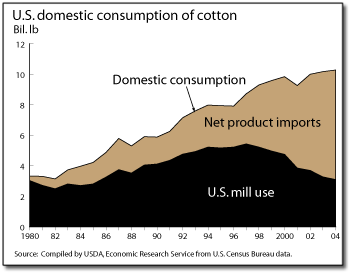Behind the Data: Estimating the Raw-Fiber Equivalent of U.S. Cotton Textile and Apparel Imports
- by Leslie Meyer
- 9/1/2005
The U.S. retail market for cotton textile and apparel products is the largest in the world, doubling in size during the past two decades. However, much of this growth is attributable to imports, as U.S. cotton mill use has contracted. Measuring the amount of raw fiber contained in textile and apparel trade is essential in estimating U.S. fiber consumption and for assessing effects on U.S. industry.
The data behind the ERS raw-fiber equivalent estimates come from product-specific shipment volumes collected by the U.S. Department of Commerce. More than 3,000 different textile and apparel products containing cotton are imported by the U.S. annually and are converted to raw-fiber equivalents using factors developed by ERS. These conversion factors adjust the weight of each textile and apparel product to account for the estimated share of cotton in the product, as well as the processing and manufacturing losses associated with producing the item. The raw-fiber equivalent data are then aggregated into major categories, such as apparel, and totaled on a monthly or annual basis for further analysis. USDA provides raw-fiber equivalent data totals back to 1960, and ERS began estimating country-specific data in the 1980s.
In 2004, the U.S. imported the equivalent of 9.5 billion pounds of raw cotton in the form of textile and apparel products, a record, with apparel accounting for 73 percent of the total. At the same time, U.S. mills used 3.1 billion pounds of cotton fiber and the U.S. exported about 2.3 billion pounds in the form of products. Although over 150 countries are involved in trade with the U.S., that trade is highly concentrated. The top five exporters to the U.S. (China, Mexico, Pakistan, Honduras, and India) accounted for 44 percent of total U.S. cotton product imports in 2004.
Import expansion has continued in 2005 as the complete removal of quotas in January allowed greater access to the U.S. market. With trade preferences diminished and many countries no longer having a guaranteed market, the more efficient countries are likely to increase their market shares, resulting in further concentration. Data for the first half of 2005 show that volume and share patterns have been altered. The top five countries now account for over half of the U.S. cotton textile and apparel import market, with China benefiting the most in the new 'quota-free' environment.
This article is drawn from:
- MacDonald, S. & Vollrath, T. (2005). The Forces Shaping World Cotton Consumption After the Multifiber Arrangement. U.S. Department of Agriculture, Economic Research Service. CWS-05C-01.
You may also like:
- Cotton and Wool. (n.d.). U.S. Department of Agriculture, Economic Research Service.


